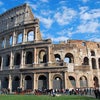The Villa Medici is an architectural complex centred on the villa whose gardens are contiguous with the larger Borghese gardens, on the Pincian Hill next to Trinità dei Monti in Rome. The Villa Medici, founded by Ferdinando I de' Medici, Grand Duke of Tuscany, has housed the French Academy in Rome since 1803. A musical evocation of its garden fountains features in Ottorino Respighi's Fontane di Roma.
In Antiquity, the site of the Villa Medici was part of the gardens of Lucullus, which passed into the hands of the Imperial family with Messalina, who was murdered in the villa.
In 1564, when the nephews of Giovanni Cardinal Ricci of Montepulciano acquired the property, it had long been abandoned to viticulture. The sole dwelling was the Casina of Cardinale Marcello Crescenzi, who had maintained a vineyard here and had begun improvements to the villa under the direction of the Florentine Nanni Lippi, who had died however, before work had proceeded far. The new proprietors commissioned Annibale Lippi, the late architect's son, to continue work. Interventions by Michelangelo are a tradition.
In 1576 the property was acquired by Cardinal Ferdinando de' Medici, who finished the structure to designs by Bartolomeo Ammanati. The Villa Medici became at once the first among Medici properties in Rome, intended to give concrete expression to the ascendancy of the Medici among Italian princes and assert their permanent presence in Rome. Under the Cardinal's insistence, Ammanati incorporated into the design Roman bas-reliefs and statues that were coming to sight with almost every spadeful of earth, with the result that the facades of the Villa Medici, as it now was, became a virtual open-air museum. A series of grand gardens recalled the botanical gardens created at Pisa and at Florence by the Cardinal's father Cosimo I de' Medici, sheltered in plantations of pines, cypresses and oaks. Among the striking assemblage of Roman sculptures in the Villa were some one hundred seventy pieces bought from two Roman collections that had come together through marriage, the Capranica and the della Valle collections. Three works that arrived at the Villa Medici under Cardinal Fernando, ranked with the most famous in the city: the Niobe Group and the Wrestlers, both discovered in 1583 and immediately purchased by Cardinal Ferdinando, and the Arrotino. When the Cardinal succeeded as Grand Duke of Tuscany in 1587, his elder brother having died, he satisfied himself with plaster copies of his Niobe Group, in full knowledge of the prestige that accrued to the Medici by keeping such a magnificent collection in the European city whose significance far surpassed that of their own capital. The Medici Vase entered the collection at the Villa, followed by the Venus de' Medici by the 1630s; the Medici sculptures were not removed to Florence until the eighteenth century. Then the antiquities from the Villa Medici formed the nucleus of the collection of antiquities in the Uffizi, and Florence began to figure on the European Grand Tour.
Like the Villa Borghese that adjoins them, the Villa's gardens were far more accessible than the formal palaces such as Palazzo Farnese in the heart of the city. For a century and a half the Villa Medici was one of the most elegant and worldly settings in Rome, the seat of the Grand Dukes' embassy to the Holy See. When the Medici became extinct in the male line in 1737, the villa passed to the house of Lorraine and, briefly in Napoleonic times, to the Kingdom of Etruria. In this manner Napoleon Bonaparte came into possession of the Villa Medici, which he transferred to the French Academy at Rome. Since then it has housed the winners of the prestigious Prix de Rome, under distinguished directors like Ingres and Balthus. Ferdinando de' Medici had a studiolo, a retreat for study and contemplation, built to the north east of the garden above the Aurelian wall. Now these rooms look onto Borghese gardens but would then have had views over the Roman countryside. These two rooms were only uncovered in 1985 by the restorer Geraldine Albers: the concealing whitewash had protected and conserved the superb fresco decoration carried out by Jacopo Zucchi 1576 and 1577.
In 1656 Christina, Queen of Sweden was said to have fired one of the cannons on top of the Castel Sant'Angelo without aiming it first. The wayward ball hit the Villa, destroying one of the Florentine lillies that decorated the facade.
In 1803, Napoleon Bonaparte moved the French Academy in Rome to the Villa Medici with the intention of preserving an institution once threatened by the French Revolution. In this way, he hoped to retain for young French artists the opportunity to see and copy the masterpieces of antiquity and the Renaissance.
At first, the villa and its gardens were in a sad state, and they had to be renovated in order to house the winners of the Prix de Rome. The competition was interrupted during the first World War, and Mussolini confiscated the villa in 1941, forcing the Academy of France in Rome to withdraw until 1945. The competition and the Prix de Rome were eliminated in 1968 by André Malraux. The Académie des Beaux-Arts in Paris and the Institut de France then lost their guardianship of the villa Medici to the Ministry of Culture and the French State.
From that time on, the boarders no longer belonged solely to the traditional disciplines (painting, sculpture, architecture, metal-engraving, precious-stone engraving, musical composition, etc.) but also to new or previously-neglected artistic fields (art history, archaeology, literature, stagecraft, photography, movies, video, art restoration, writing and even cookery.) Artists are no longer recruited by a competition but by application, and their stays generally vary from six to eighteen months.
The villa, its out-buildings, and its grounds were the object of a new rehabilitation and modernization campaign, in which the restoration of the facade over the gardens constitutes the most spectacular step. Work continued under the direction of the previous director, Richard Peduzzi, and the Villa Medici resumed organizing exhibitions and shows created by its boarders.





